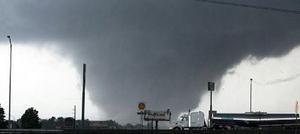DisastersUnderstanding deadly tornadoes
Scientists at the University of Alabama in Huntsville (UAH) are analyzing radar data from 27 April 2011 — the day that saw of the deadliest tornado outbreaks in U.S. history — then merging the information with detailed storm surveys and other data; they hope to learn more about how the storms formed, what made the storms so powerful and what might be done to make tornado warnings more effective

Tuscaloosa tornado of 27 April 2011 // Source: ljworld.com
It was one of the deadliest tornado outbreaks in U.S. history. Now scientists are organizing a research program better to understand the tornadoes that blew through Alabama and other southeastern states on 27 April 2011.
Scientists at the University of Alabama in Huntsville (UAH) are analyzing radar data from that day, then merging the information with detailed storm surveys and other data. They hope to learn more about how the storms formed, what made the storms so powerful and what might be done to make tornado warnings more effective.
The National Science Foundation (NSF) funds the project through a Rapid Response Research (RAPID) grant, which enables support for fast-response research tied to events such as tornadoes.
“Heavily forested rolling terrain and limited public awareness may present unique challenges to tornado detection in this area and to widespread dissemination of and effective public response to severe weather warnings,” said Brad Smull, program director in NSF’s Division of Atmospheric and Geospace Sciences, which funded the RAPID award.
A National Science Foundation (NSF) release reports that in addition to studying the physics of the storms, the team will look at the psychology and sociology of storm warnings.
A graduate student from the University of Oklahoma and UAH student volunteers and scientists are interviewing survivors to learn more about how and when people reacted to that day’s repeated tornado warnings.
“One thing we’re after is whether people are desensitized because the false alarm rate is so high, especially in areas where there are only countywide alerts,” said Kevin Knupp, who leads UAH’s severe weather research team.
Data compiled by UAH scientist Tim Coleman shows about a ten-fold increase in warnings among Memphis, Atlanta and Tallahassee since the National Weather Service (NWS) installed the NEXRAD Doppler radar system, and that about 80 percent of all warnings are “false.”
The increase in warnings is due in large part to the NEXRAD radar’s ability to spot “rotation” inside a storm system.
Installed between 1993 and 1997, the five NEXRAD radar units in Alabama are also better at detecting small tornadoes than the previous system.
“Before NEXRAD we didn’t know these rotational elements along squall lines were so prevalent,” Knupp said. “If a small tornado didn’t cause property damage or wasn’t reported, we
